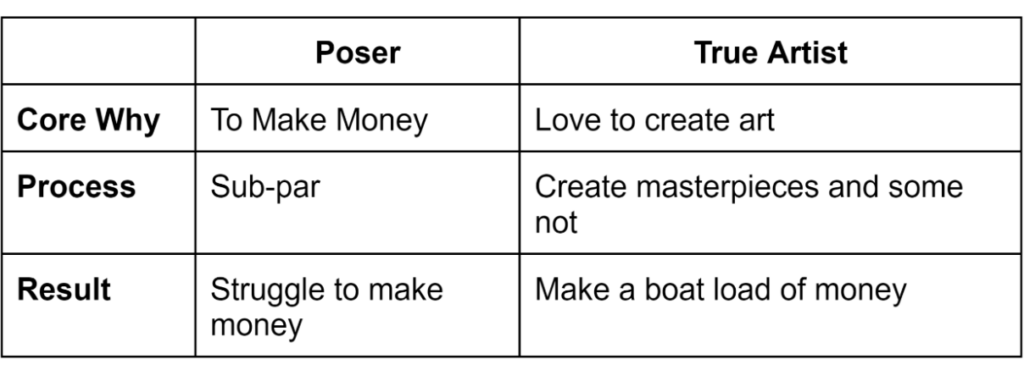For most athletes, traditional goal setting is holding them back. Yes you read that right.
Goal setting itself is not the problem.
The problem is being obsessed with results.
You can want and care about results, but the best athletes in the world are more obsessed with the process than results. This can be easier said than done.
I learned how big of a problem this is first hand. As a junior hockey player, I obsessed about points and my spot in the lineup.
The more I obsessed about results, the harder it was to achieve my goals.
It was infuriating to want something so bad and work so hard, but when it was time to perform, I was in my own head, forcing plays, and underachieving.
I eventually realized I needed to let go of the results and prioritize my mental game.
Symptom vs Root Problem
What I didn’t understand, and most athletes don’t understand, is the difference between a symptom and the root problem.
The symptom you might be experiencing could be:
- Overthinking
- Lack of confidence
- Performance anxiety
- Choking under pressure
- Afraid to make mistakes
- Worrying about what other people think
But the key to resolving the symptom is to clear your mental blocks.
Also known as getting to the root of the problem.
And based on the thousands of mindset assessments we have conducted, it is unanimous that the most common and biggest root problem is an obsession with results.
The Process vs Results Paradox
Clearing this mental block, aka The Results Trap, can be challenging for numerous reasons.
First of which is the overuse of traditional goal setting that perpetuates this trap.
Second, is the Process vs Results Paradox – where by letting go of results and obsessing about the process, you will achieve greater results.
This presents a unique problem – if you try to let go of results so you can achieve results, then you have not let go of the results.
So you need a different reason to let go of the results, and I’m going to share that with you right now.
Here are the 3 steps to stop obsessing about results and start enjoying the journey.
STEP 1: Separate Your Goals from Your Why
The mistake most people make is they think the main reason they do something is to achieve the goals they have set.
Although there is ‘some’ truth to this, it will leave you in the results trap and it is not the full truth.
This is best illustrated with the fictional Flowerbed Story…
A group of twelve year old kids started playing touch football in this old-ladies backyard.
The yard was perfectly set up with a flower bed as the touchdown zones on both sides.
The kids absolutely loved playing – especially when they would jump to catch the touchdown pass and land in the nice soft flower beds.
The old-lady didn’t like this so much. She would yell at them to stop playing, but they just kept coming back.
She thought about calling the cops but they were only 12 years old.
So she got a sneaky idea where she started to pay them $5 each to play.
At first all the boys were really excited. Not only did they get to keep playing the game they loved, they were getting paid to play.
This went on for a few weeks until the old-lady started to pay them less and less.
First it went to $2, then $1, then 25 cents, until eventually the kids decided:
Screw this, we aren’t playing here any more.They had completely forgotten why they were playing in the first place.
Side note: I’ve known this story for a long time, but I have not been able to trace down the origins of it – so if you do know the origins please let me know.
Although not all athletes are getting paid to play, the shiny objects of praise and results are what distract them as they climb the ranks.
You can have the goals and intentions to achieve certain results, but don’t confuse this for why you started playing your sport in the first place.
STEP 2: Intentionally Set Your Priorities
Now that you understand the difference between your why and your goals, you need to keep your why and your mindset your top priority.
There are three main categories athletes can set as their priorities:
Blue = Mindset
Green = Skills
Red = Results
When I ask most athletes which of these they prioritize on game day, the order goes:
1. Results
2. Skills – so they can achieve the results
3. Mindset – so they can be confident and execute the skills to achieve the results
This is the Process vs Results Paradox all over again. As long as that is the order of priorities, then the Mindset will suffer, which means the results will suffer.
So the challenge is for you to consistently and intentionally put your mindset as your top priority.
Be ready for the sport structure and the people around to pull you back towards results as the top priority.
You will need to intentionally fight against this. All of the strategies we teach athletes will help, but one in particular is the personal scorecard.
When an athlete finally gets this and can consistently keep their mindset the top priority, then they can truly start to enjoy the journey.
Similarly, this also applies to parents of athletes.
I recently had a parent of an athlete call me to explain that he, the parent, had made a major shift in his mentality.
He had wanted his son to be more process focused and have a stronger mental game so his son could achieve greater results. Which makes sense, but he, the parent, was still prioritizing the results.
Although the goal and intention to achieve results is still there, he has finally made the shift to prioritize the experience for the sake of itself.
He started appreciating the time he gets to spend with his son on the drive to and from events. He started having a healthier perspective on the range of results and having more patience in the face of adversity.
And most importantly, the whole sporting experience became less stressful for both him and his son because of this mental shift.
He was finally enjoying the journey as a parent.
STEP 3: Learn to Enjoy the Journey
One of the most common clichés in sports is Have Fun.
The problem is most athletes are not having fun – mainly because they are still stuck in the results trap.
When you are in the results trap all the fun is tied to achieving results.
But ALL the fun should not be tied to the destination. Rather, the majority of the enjoyment in sport is the journey.
This is why we say – the biggest benefit to mental training is not helping you achieve Consistent Elite Performance, but rather, enjoying the journey.
Instead of framing enjoyment as something you experience, we want to frame it as something you can learn to do.
Here are the 4 core concepts you need to develop:
Acceptance
This does not mean becoming a hippie and not caring about anything. Rather, it is the ability to accept the range of results. So you can commit to the process.
I wrote and spoke more in-depth on this concept in the Reset Routine post.
Commitment
Commitment paired with acceptance is like a superpower. It allows you to fully let go of the results while fully committing to the process.
This is key to being in the moment and enjoying the journey.
Centered
The pursuit of high-performance inherently is filled with challenges and setbacks. So it is crucial to stay grounded or even-keeled through the highs and the lows.
This does not mean trying to take out the passion and emotion of the experience. Rather, it is about staying in control of your emotions. Credit to Trevor Moawad for popularizing the concept of neutral thinking.
Enjoyment
This concept brings us full circle to the point of this entire blog post. If you lose sight of your why, your love of the game, and you stop enjoying the journey – everything else suffers. But when you learn to enjoy the game for the sake of itself, everything else falls into place.
I like to illustrate this point with the poser vs true artist example:

In short, step 3 is learning how to enjoy the journey by actively working on your mental game and the four core concepts.
________________________________________________________________________________________
So when you are setting goals keep these three steps in mind to make sure you don’t fall victim to the results trap.
One other important tip to effectively setting goals is to set a range of targets. i.e. good, better, and best goals. This helps you be both realistic yet ambitious. And it helps set you up to better accept the range for results and just attack the process.
In summary, you can stop obsessing about results and start enjoying the journey by following these 3 steps:
- Separate Your Goals from Your Why
- Intentionally Set Your Priorities
- Learn to Enjoy the Journey
I hope you found this helpful.
Please share this with anyone you think might benefit from this post.

 Nicholas is a Senior High-Performance Coach and holds a doctorate in Sport & Exercise Psychology. From his specialized psychology research program, to his PhD studies, Nicholas has gained a tremendous foundation of knowledge and appreciation for the human experience. His passion for psychology has accumulated to a commitment to studying and applying performance psychology and stoicism. This commitment has led Nicholas to conduct many research studies focusing on understanding why and how some people thrive and prosper while others do not. His admiration for evidence-based solutions has propelled Nicholas to produce studies revolving around mindfulness, grit (perseverance and passion), performance, quality participation, social relationships, and well-being.
Nicholas is a Senior High-Performance Coach and holds a doctorate in Sport & Exercise Psychology. From his specialized psychology research program, to his PhD studies, Nicholas has gained a tremendous foundation of knowledge and appreciation for the human experience. His passion for psychology has accumulated to a commitment to studying and applying performance psychology and stoicism. This commitment has led Nicholas to conduct many research studies focusing on understanding why and how some people thrive and prosper while others do not. His admiration for evidence-based solutions has propelled Nicholas to produce studies revolving around mindfulness, grit (perseverance and passion), performance, quality participation, social relationships, and well-being. A Native of Quebec, Sara was part of the St. Lawrence University Women’s Ice Hockey team that competed in the NCAA Division 1 hockey league ECAC. During this time, Sara helped her team appear in four ECAC Hockey Tournaments and two NCAA Frozen Fours, and was a four-time member of the ECAC Hockey All-Academic Squad. Following her career at St. Lawrence University, Sara played one year of professional hockey with Lugano, where she truly honed her skills in understanding the intricate connection between mindset and performance.
A Native of Quebec, Sara was part of the St. Lawrence University Women’s Ice Hockey team that competed in the NCAA Division 1 hockey league ECAC. During this time, Sara helped her team appear in four ECAC Hockey Tournaments and two NCAA Frozen Fours, and was a four-time member of the ECAC Hockey All-Academic Squad. Following her career at St. Lawrence University, Sara played one year of professional hockey with Lugano, where she truly honed her skills in understanding the intricate connection between mindset and performance.
 Blair has over 13 years of experience as a Professional Dancer, Assistant Dance Captain & Cast Manager, as well as an additional 17 years of training. Over the last 3 decades, she has lived and experienced first hand the highest of highs & lowest of lows that come with pursuing a career in the Performing Arts.
Blair has over 13 years of experience as a Professional Dancer, Assistant Dance Captain & Cast Manager, as well as an additional 17 years of training. Over the last 3 decades, she has lived and experienced first hand the highest of highs & lowest of lows that come with pursuing a career in the Performing Arts.

 Natasha Habert draws from her training in sport and performance psychology, personal experiences as a competitive athlete, and deep passion for consistent high performance. She is a lifelong athlete and high performer, excelling in volleyball as both a player and coach.
Natasha Habert draws from her training in sport and performance psychology, personal experiences as a competitive athlete, and deep passion for consistent high performance. She is a lifelong athlete and high performer, excelling in volleyball as both a player and coach. Luciano’s hockey career is highlighted by his time playing college at the University of Victoria and two professional seasons in Europe. Throughout his career, he struggled with performance anxiety, a lack of consistency, fluctuations in confidence, and being caught in the results trap. This eventually led him to deviate from the main reason why anyone should play sports – for the enjoyment of the game. As a former athlete, Luciano has a unique understanding of the psychological pressures and struggles that athletes experience.
Luciano’s hockey career is highlighted by his time playing college at the University of Victoria and two professional seasons in Europe. Throughout his career, he struggled with performance anxiety, a lack of consistency, fluctuations in confidence, and being caught in the results trap. This eventually led him to deviate from the main reason why anyone should play sports – for the enjoyment of the game. As a former athlete, Luciano has a unique understanding of the psychological pressures and struggles that athletes experience. Alexis Woloschuk is a name synonymous with mental fortitude in the world of professional hockey. Throughout her career originating playing boys hockey, going to an academy away from home, playing her four years at Boston University and 7+ years in pro hockey she’s learned the importance of resilience, confidence, and dismissing both fear and other’s opinions. With a blend of relatability, confidence, and an acute understanding of playing to one’s potential, Alexis helps athletes reshape the way they perceive and harness the power of their minds.
Alexis Woloschuk is a name synonymous with mental fortitude in the world of professional hockey. Throughout her career originating playing boys hockey, going to an academy away from home, playing her four years at Boston University and 7+ years in pro hockey she’s learned the importance of resilience, confidence, and dismissing both fear and other’s opinions. With a blend of relatability, confidence, and an acute understanding of playing to one’s potential, Alexis helps athletes reshape the way they perceive and harness the power of their minds. Sean Mahoney is a member of the Association for Applied Sport Psychology (AASP), and a Master’s candidate in the Sport and Performance Psychology program at the University of Denver. For as long as he can remember, Sean has been fascinated by human performance and how to gain an edge over the competition. For most of his athletic career, he focused on the physical aspect of performance but neglected the mental. Because of this, he struggled with performance anxiety, focus issues, and limiting beliefs pertaining to confidence and self-doubt. His lack of focus on optimizing his mental game prevented him from reaching his full potential.
Sean Mahoney is a member of the Association for Applied Sport Psychology (AASP), and a Master’s candidate in the Sport and Performance Psychology program at the University of Denver. For as long as he can remember, Sean has been fascinated by human performance and how to gain an edge over the competition. For most of his athletic career, he focused on the physical aspect of performance but neglected the mental. Because of this, he struggled with performance anxiety, focus issues, and limiting beliefs pertaining to confidence and self-doubt. His lack of focus on optimizing his mental game prevented him from reaching his full potential. Savannah Fitzgerald is earning her M.A. in Kinesiology, Sport Psychology Option at California State University, Fresno. Possessing an internal motor that fires her rage for success, Savannah forged this attribute over five years while competing as an NCAA D-I water polo player and swimmer. Combined with her opportunity to represent and compete for the United States, she feels that sport has significantly impacted her professional development. Due to her personal experience playing at all levels, Savannah’s passion for mental performance began when she struggled to overcome pre-competition nerves and post-competition processing. When she discovered a world out there that people were referring to as ‘sport psychology,’ she felt like a piece of her brain was unlocked. Reality shifted as she stumbled into a space consisting of the most beautiful blend of elite performance, mental well-being, and athletics.
Savannah Fitzgerald is earning her M.A. in Kinesiology, Sport Psychology Option at California State University, Fresno. Possessing an internal motor that fires her rage for success, Savannah forged this attribute over five years while competing as an NCAA D-I water polo player and swimmer. Combined with her opportunity to represent and compete for the United States, she feels that sport has significantly impacted her professional development. Due to her personal experience playing at all levels, Savannah’s passion for mental performance began when she struggled to overcome pre-competition nerves and post-competition processing. When she discovered a world out there that people were referring to as ‘sport psychology,’ she felt like a piece of her brain was unlocked. Reality shifted as she stumbled into a space consisting of the most beautiful blend of elite performance, mental well-being, and athletics. Gabe is currently completing his Master’s in Counselling Psychology at the University of Victoria. Although Gabe played several years of high-level baseball, including a stint in the British Columbia Premier Baseball League (BCPBL), he chose hockey as his sport to pursue at the highest level possible. Gabe went on to play four years of junior hockey with the Richmond Sockeyes in the Pacific Junior Hockey League (PJHL) while also coaching minor hockey. Prior to junior hockey, Gabe played 3 years in the Canadian Sport School Hockey League (CSSHL) where he experienced the pressures and expectations of moving on to the next level. During those three years, Gabe constantly compared himself to others and struggled with coping when things did not go his way. Over time, he learned how to focus on his own process and path to the next level, while also developing strategies to improve well-being.
Gabe is currently completing his Master’s in Counselling Psychology at the University of Victoria. Although Gabe played several years of high-level baseball, including a stint in the British Columbia Premier Baseball League (BCPBL), he chose hockey as his sport to pursue at the highest level possible. Gabe went on to play four years of junior hockey with the Richmond Sockeyes in the Pacific Junior Hockey League (PJHL) while also coaching minor hockey. Prior to junior hockey, Gabe played 3 years in the Canadian Sport School Hockey League (CSSHL) where he experienced the pressures and expectations of moving on to the next level. During those three years, Gabe constantly compared himself to others and struggled with coping when things did not go his way. Over time, he learned how to focus on his own process and path to the next level, while also developing strategies to improve well-being. Louie is a mental performance coach from Toronto, Canada with a professional hockey career spanning over 14 years. Being a standout player at the University of Michigan, Louie was a Hobey Baker finalist and a 1st team All-American, which led him to getting drafted by the Ottawa Senators and playing in renowned leagues across the globe, including the DEL, SHL, and AHL.
Louie is a mental performance coach from Toronto, Canada with a professional hockey career spanning over 14 years. Being a standout player at the University of Michigan, Louie was a Hobey Baker finalist and a 1st team All-American, which led him to getting drafted by the Ottawa Senators and playing in renowned leagues across the globe, including the DEL, SHL, and AHL.
 Mia Landry is a former varsity hockey player at Brock University, where she competed at the USPORT level and was part of the 2021-22 OUA gold medal team. Mia currently represents Canada on the Women’s National Ball Hockey team and is pursuing a Master of Kinesiology Sport Psychology at her alma mater. Her research focuses on areas such as team cohesion, group dynamics, leadership styles, and sports culture.
Mia Landry is a former varsity hockey player at Brock University, where she competed at the USPORT level and was part of the 2021-22 OUA gold medal team. Mia currently represents Canada on the Women’s National Ball Hockey team and is pursuing a Master of Kinesiology Sport Psychology at her alma mater. Her research focuses on areas such as team cohesion, group dynamics, leadership styles, and sports culture. As a former member of McMaster University’s women’s soccer team, Emilie intimately understands the demands and challenges athletes face on and off the field. Although she encountered many challenges as a high-level athlete, particularly struggling with self-doubt and overthinking, Emilie was able to make a remarkable transformation when she began to embrace the principles of sports psychology.
As a former member of McMaster University’s women’s soccer team, Emilie intimately understands the demands and challenges athletes face on and off the field. Although she encountered many challenges as a high-level athlete, particularly struggling with self-doubt and overthinking, Emilie was able to make a remarkable transformation when she began to embrace the principles of sports psychology. Max is currently attending William James College, where he is earning a Doctorate Degree in Clinical Psychology and a Masters Degree in Professional Psychology. During his time as an undergraduate student, Max was inducted into the International Honor Society in Psychology (Psi Chi), and played on the Quinnipiac University men’s club ice hockey team.
Max is currently attending William James College, where he is earning a Doctorate Degree in Clinical Psychology and a Masters Degree in Professional Psychology. During his time as an undergraduate student, Max was inducted into the International Honor Society in Psychology (Psi Chi), and played on the Quinnipiac University men’s club ice hockey team.







